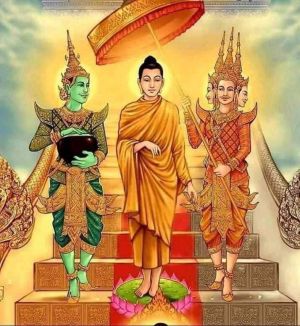Mengakdé
Mengakdé (Tib. མན་ངག་སྡེ་, Wyl. man ngag sde, THL. mengakdé, Sanskrit: upadeśavarga), or Instruction Class, is the third of three divisions of the Dzogchen teachings according to the Nyingma school of Tibetan Buddhism. The other two divisions are Semdé (mental class) and Longdé (mind class).
The Mengakdé are regarded as the highest of the three classes of teachings, and "they have constituted the core of Nyingma practice since the eleventh century."[1]
Mengakdé emphasizes the Dzogchen practices of kadak trekchö and lhündrup tögal.
Mengak refers to the most essential and practical instructions for a set of teachings.[2]
Dé refers to a section, class, division, etc.
The term Mengakdé has been translated as:
Instruction class (Princeton Encyclopedia of Buddhism)
Instruction section (Rangjung Yeshe Wiki)
Cagtegory of Pith Instructions (Rigpa Wiki)[2]
Category of Direct Transmission (Richard Baron)[2]
Menngagde in the Dzogchen textual tradition
According to tradition, Mañjuśrīmitra classified all the Dzogchen teachings transmitted by his teacher, Garab Dorje, into three classes:[3]
Mañjuśrīmitra's student Sri Singha further divided the Manngagde section into four sub-sections (see below).
Sri Singha transmitted these teachings to Jñānasūtra and Vimalamitra. Vimalamitra is said to have taken the Mengakdé teachings to Tibet in the 8th Century.
The Glossary for Rangjung Yeshe Books presents the lineage of the Mengakdé teachings as follows:
The third of the Three Sections of Dzogchen, as arranged by Manjushrimitra. In Tibet three lineages are represented: through Padmasambhava and Vairotsana who both received transmission from Shri Singha, and through Vimalamitra who received transmission partly from Shri Singha and partly from Jnanasutra. The two former lineages were continued only as termas while Vimalamitra's was passed on both as terma and as oral transmission. In the following millennium, innumerable termas have been revealed containing the precious instructions of these three great masters. The most important of these terma treasures are included in the Rinchen Terdzo, a collection of termas by Jamgon Kongtrul covering the Three Inner Tantras and in Nyingtig Yabzhi.
Distinguishing features
The distinguishing features of Mengakdé are the practices of lhündrup tögal and kadak trekchö.
Within the instruction section there are two aspects: kadag trekchö, the cutting through of primordial purity, and lhündrub tögal, the direct crossing of spontaneous presence.[5]
Germano & Gyatso (2000: p. 240) note a similarity of practice between Chan-like formless meditations and Nyingthik/Mengakdé:
"...the Seminal Heart or Nyingthik (snying thig) form of the Great Perfection (rdzogs-chen) movement, ...a syncretic Tantric tradition consisting of Chan-like practices of formless meditation combined with exercises that cultivated spontaneous visions of buddhas."[6]
Four divisions
The Dzogchen master Sri Singha divided the Mengakdé teachings into four cycles or sections, sometimes called the "Four Cycles of Nyingtig" (Wylie: snying thig skor bzhi). The four cycles are:
Outer Cycle
Inner Cycle
Innermost Unexcelled Cycle (Wylie: yang gsang bla na med pa'i snying thig gi skor)
The fourth division of the Mengakdé teachings, the Innermost Unexcelled Cycle, came to be known as Nyingthik ("innermost essence").[7]
Variations of the name of the fourth section include:
the Secret Heart Essence (gsang ba snying thig),
the Most Secret Unexcelled Nyingtig (yang gsang bla na med pa snying tig),
the Innermost Unexcelled Cycle of Nyingtig (yang gsang bla na med pa'i snying thig skor),
the Most Secret and Unexcelled Great Perfection (yang gsang bla na med pa rdzogs pa chen po),
the Most Secret Heart Essence (yang gsang snying thig),
the Most Secret Unsurpassable Cycle (yang gsang bla na med pa'i sde) and the Vajra Heart Essence.
Main article: Seventeen Tantras of Menngagde
This fourth section of Mengakdé is said to contain the seventeen tantras, although there are eighteen when the Ngagsung Tromay Tantra is added, and nineteen including the Longsel Barwey Tantra (Tantra of the Blazing Space of Luminosity).[8]
Notes
Princeton Dict icon 166px.png Buswell & Lopez 2014, man ngag sde
RW icon height 18px.png Pith Instructions
"Archived copy". Archived from the original on 2007-10-08. Retrieved 2007-02-01.
"Glossary for Rangjung Yeshe Books". Rangjung Yeshe Publishing.
Schmidt, Marcia Binder (Ed.) (2002). The Dzogchen Primer: Embracing The Spiritual Path According To The Great Perfection. London, Great Britain: Shambhala Publications, Inc. ISBN 1-57062-829-7 pg. 38)
Germano, David; Gyatso, Janet (2000). Longchenpa and the Possession of the Dakinis. in: White, David Gordon (author, editor)(2001). Tantra in practice. Motilal Banarsidass Publ. p. 240. ISBN 978-81-208-1778-4. Retrieved March 27, 2010.
Tulku Thondup 1996, p. 4.
http://www.yoniversum.nl/dakini/tantras17.html
